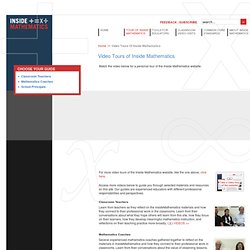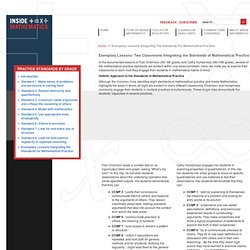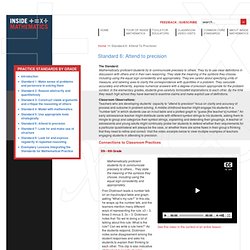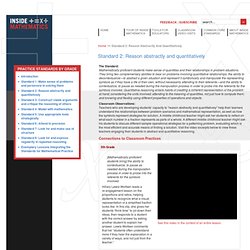

Video Tours of Inside Mathematics. Watch the video below for a personal tour of the Inside Mathematics website.

For more video tours of the Inside Mathematics website, like the one above, click here. Access more videos below to guide you through selected materials and resources on this site. Our guides are experienced educators with different professional responsibilities and perspectives. Classroom Teachers Learn from teachers as they reflect on the InsideMathematics materials and how they connect to their professional work in the classrooms. Mathematics Coaches Several experienced mathematics coaches gathered together to reflect on the materials in InsideMathematics and how they connect to their professional work in classrooms. School Principals Hear school principals discuss mathematics as a focus at their school, promotion of a professional learning community around mathematics, and the role that misconceptions play in mathematics teaching and learning.
Inside Mathematics. Exemplary Lessons. In the documented lessons of Fran Dickinson (5th/ 6th grade) and Cathy Humphreys (9th/10th grade), several of the mathematical practice standards are evident within one lesson/problem.

Here, we invite you to explore their classrooms to learn how they engage their students in mathematical habits of mind. Holistic Approach to the Standards of Mathematical Practice Although the Common Core identifies eight standards of mathematical practice and Inside Mathematics highlights the ways in which all eight are evident in many different classrooms, Dickinson and Humphreys commonly engage their students in multiple practices simultaneously. These single clips demonstrate the students’ capacities in several practices.
Classroom Environments to Support Content Learning To support their students’ content learning, Dickinson and Humphreys have established a rapport with their students and a set of norms for students to turn and talk to each other as they work together. Learn More 1. 2. 3. 4. 5. 6. Standard 8. Mathematically proficient students notice if calculations are repeated, and look both for general methods and for shortcuts...

They continually evaluate the reasonableness of their intermediate results. In Elysha Pesseggi’s 4th grade classroom, students work on a number talk asking them to evaluate the reasonableness of a two-digit problem and solution—to “see if they might be true or false without thinking.” As her students discuss their rationales for determining why 62 + 78 is or is not equal to 238, various students offer responses that the numbers are “too small” or “would have to be bigger.”
Early on, a student observes that “to get 200 you’d need at least 100 and 100.” Later in the discussion, a student advances this idea, stating that “two 2-digit numbers cannot…no matter what… if it’s addition…cannot be more than 198.” Standard 7. Standard 6. Mathematically proficient students try to communicate precisely to others.

They try to use clear definitions in discussion with others and in their own reasoning... By the time they reach high school they have learned to examine claims and make explicit use of definitions. Cathy Humphreys leads an extended exploration of a proof of the properties of quadrilaterals, helping students learn to investigate, formulate, conjecture, justify, and ultimately prove mathematical theorems. In these clips, students engage in the first of two block-length explorations of their proofs. Standard 5. Standard 4. Standard 3. Mathematically proficient students understand and use stated assumptions, definitions, and previously established results in constructing arguments.

They make conjectures and build a logical progression of statements to explore the truth of their conjectures. They are able to analyze situations by breaking them into cases, and can recognize and use counterexamples. They justify their conclusions, communicate them to others, and respond to the arguments of others. They reason inductively about data, making plausible arguments that take into account the context from which the data arose.... Students at all grades can listen or read the arguments of others, decide whether they make sense, and ask useful questions to clarify or improve the arguments.
Cathy Humphreys leads an extended exploration of a proof of the properties of quadrilaterals, helping students learn to investigate, formulate, conjecture, justify, and ultimately prove mathematical theorems. Standard 2. Mathematically proficient students make sense of quantities and their relationships in problem situations...

Quantitative reasoning entails habits of creating a coherent representation of the problem at hand; considering the units involved; attending to the meaning of quantities, not just how to compute them; and knowing and flexibly using different properties of operations and objects. Joe Condon presents a lesson study for 6th grade students and observing teachers to identify strategies for comparing unit rates. In these clips, he starts by establishing classroom norms for active listening. Then he engages the class in a whole-group experiment of the teacher power walking a 5-meter strip. The members of the class are given jobs for collecting data or monitoring time. Students conduct 3 rate experiments: stringing beads on a shoelace, picking up cubes with chopsticks, and counting rice. Standard 1.